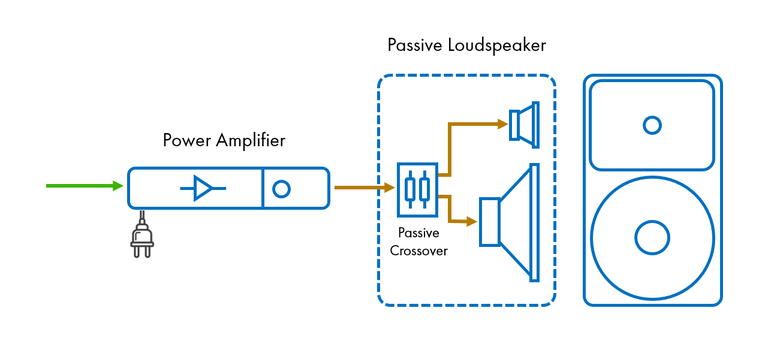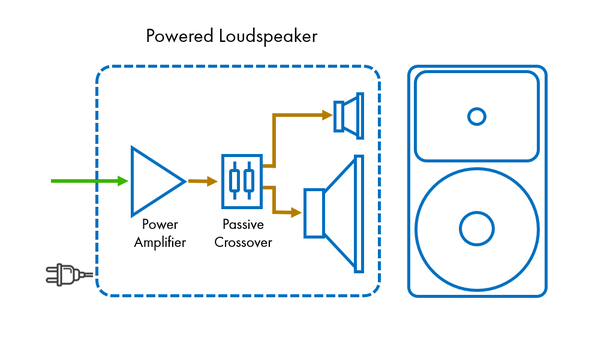Whether you’re listening to live music in a club, to a film soundtrack at the movie theater, or enjoying some tunes while wearing headphones, the sound you’re listening to is reproduced by loudspeakers. Everyone understands that. Now, designing loudspeakers, which produce sounds that are accurate and enjoyable, can be done in a few different ways. You can have passive loudspeakers, active loudspeakers, or powered loudspeakers. When describing such designs and their technology, it is very common to read erroneous use of the terminology. So, let’s bring some technical clarity here.
Before looking into the details of each technology, we need to define a few elements around our explanations. First, this article assumes that we have an audio source feeding a line level signal (the most common level for professional equipment is +4 dBu, and -10 dBV for consumer equipment) to each design we are going to discuss. Line levels are documented in green in the drawings below, while full swing (many tens of dB’s), post power amplifier signals are indicated in bronze.
The Passive Loudspeaker
Danish engineer Peter L. Jensen and Edwin Pridham manufactured the first practical moving-coil loudspeakers in 1915, in Napa, California. They invented the commonly called passive loudspeaker design, which is still in use and globally manufactured by many brands, including QSC (see our E Series).
Passive loudspeakers are made of an enclosure, one or more transducers (also called loudspeaker drivers), and a passive crossover network. They do not require any mains power – the electrical power taken from wall sockets (230 V, 110 V, etc.) – as their transducers are working with passive electrical components and electromagnetic forces. They receive an amplified line level signal (in bronze below) from a standalone power amplifier. The power amplifier boosts the line level signal from the audio source and/or preamplifier to an adequate transducer signal level. Next, this signal is split into different frequency bandwidths – typically two or three – by the passive crossover network mounted inside the enclosure before being sent to the appropriate transducers.

Note that the power amplifier’s output rating and the passive loudspeaker admissible power must be carefully matched to achieve optimal performance. A too weak amplifier will be incapable of driving the loudspeaker to its full performance and will distort the audio signal before the loudspeaker even gets close to its loudest. Conversely, too powerful of an amplifier can overload the passive loudspeaker crossover and transducers, leading to distortion and transducers blowing up.
The Active Loudspeaker
The first active loudspeakers were designed in the mid 60’s by the likes of JBL and Klein & Hummel, and soon after by Altec and Meyer Sound. An active loudspeaker design implies the use of one or more enclosures, one or more transducers, an active crossover network and separate, dedicated power amplifiers for each of the frequency bands split up by the active crossover network.
An active loudspeaker is designed to receive a line level signal from an audio source and/or preamplifier and amplify (and process) this signal internally. To do so, mains power is required. First, the line level signal is separated into different frequency bands by the active crossover network. Then, each band is amplified separately to transducer level before driving each appropriate driver (tweeter, midrange, woofer – depending on the design).


Using that technology, active crossover networks can be better optimized to split the audio signal with clarity and precision since they are independent from any power handling issues. The line-level signal separation occurs at a much lower amplitude than transducer level signals. In addition, as the designers have full control on all components in the design, each element can be optimized to achieve the best possible audio performance. One example is the perfect impedance matching between each power amplifier output and the corresponding transducer input impedance.
Several other technical benefits exist in active designs such as the possibility to have on-board driver equalization, advanced protection circuitry (thermal dissipation, driver excursion, electronic clipping, etc) as well as digital signal processing (DSP) using additional A/D (analog-to-digital) and D/A stages as featured in QSC K.2, KLA, KW and CP Series.
The Powered Loudspeaker
Powered loudspeakers and active loudspeakers are often confused. If the terms “powered” and “active” are used interchangeably to describe loudspeaker designs – in marketing communications especially – a clear differentiation between these technologies should be made.
Technically, powered loudspeakers are either similar to passive loudspeakers or using a combination of passive and active technologies. The big difference is that a powered loudspeaker does not strictly have individual power amplifiers for each transducer. Also, the presence of a passive crossover network in the design sets it apart from a pure active loudspeaker design. The inherent compromises of passive crossover networks (not covered in this article) are part of the powered loudspeaker paradigm.
In figure 4 below, the powered loudspeaker design illustrated works in the same way as a passive loudspeaker, except that a single channel power amplifier is built inside the loudspeaker enclosure. Thus, the term “powered” loudspeaker, as it requires mains power. In terms of electronic and acoustic performance, this “powered” loudspeaker is no different from a conventional passive loudspeaker. Such designs are common in compact personal loudspeakers such as those used to amplify portable digital music devices.

In the next figure 5, the powered loudspeaker design features an active crossover, which separates the line level signal in two distinct bands. If the woofer channel has a dedicated power amplifier before the actual transducer (making this channel truly ‘active’), the second channel is then split once more via a passive crossover network to retrieve a tweeter and a midrange frequency band. If such a 3-way powered loudspeaker design requires mains power, it is technically only partially active (woofer channel).

A number of studio monitors and hi-fi loudspeakers are designed in that way with the aim to reduce costs, as they only need two power amplifier channels rather than a more complex 3-way active crossover network feeding three separate power amplifiers.
Conclusion
If your loudspeaker – and its internal passive crossover – is not connected to mains power, then you are listening to a passive loudspeaker. Beside large venues complex PA systems, if your loudspeaker is connected to mains power, then it is beneficial to know if your loudspeaker features an actual active design or a ‘hybrid’ powered one.
To summarize, all active loudspeakers require mains power (they are ‘powered’), but not all powered loudspeakers should be called active. So, watch out and make sure you purchase precisely the loudspeaker technology you need. Do not be fooled by words. Happy listening!
